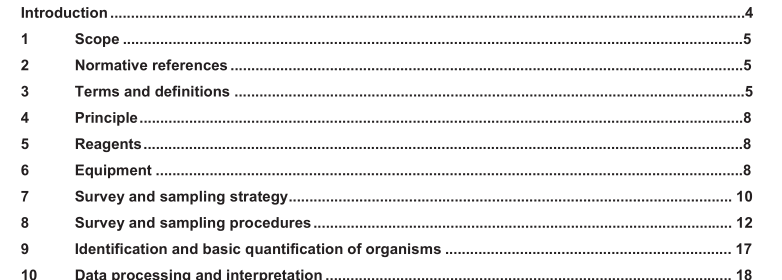EN 15708:2009 – Water quality – Guidance standard for the surveying, sampling and laboratory analysis of phytobenthos in shallow running water

7 Survey and sampling strategy
7.1 Approaches Any reach within a river or stream is likely to contain a number of different substrata on which phytobenthos can grow, and some of these substrata may, in turn, be colonised by more than one type of phytobenthic growth form. In many cases, these growth forms will be visible to the naked eye, even if the constituent organisms are microscopic. In some cases, the growth form will contain one, or a few, dominant organism(s) along with epiphytes and loosely-associated taxa. The dominant organism(s) may be identified in the field, although it may be necessary to confirm the identity in the laboratory.
In other cases (e.g. epilithic biofilms), the dominant organism may be too small to be identified in the field. The result is that any survey unit will contain a wide variety of growth forms that may need to be recorded and/or sampled. Analysis of the phytobenthos at a site/survey unit consists of three stages, which can be combined in various ways to give a number of survey/sampling strategies, each applicable to different purposes. These stages are: Survey: a detailed inspection of a defined length of the river or stream, recording the nature of the stream environment, the substrata available for phytobenthos and the nature and abundance of any phytobenthic growth forms present.
Sampling: removal of small quantities of some or all the phytobenthic growth forms for subsequent examination in the laboratory.
Laboratory analysis: identification and abundance assessment of the organisms present in the growth forms. In a few cases (e.g. Hildenbrandia rivularis), species-level determinations can be made in the field but in most cases, the identities of macroscopic algae and bryophytes should be checked in the laboratory unless the surveyors have proven competence in field identification of these organisms. These three stages are combined, in different ways, to give the following sampling strategies:
Macroscopic Phytobenthos Survey (MPS): detailed survey of all, or a selection, of the phytobenthic growth forms that are visible with the naked eye, with sampling and laboratory analysis confined to checking the identities of macroscopic algae (and optionally bryophytes). MPS provides semi-quantitative (or, with slight modification, quantitative) estimates of the abundance of those taxa that are visible to the naked eye. It is recommended for trend monitoring and, particularly, for detecting changes in abundance of those algae such as Cladophora and Hydrodictyon which are capable of proliferating to “nuisance” quantities.
Multi Habitat Sampling (MHS): survey and sampling of all available habitats/substrata in order to compile a list, with semi-quantitative estimates of abundance, of all phytobenthic taxa present at a survey unit. MHS best characterises the phytobenthos in the reach, but results may not be sensitive to subtle water quality differences because of habitat differences between reaches.
EN 15708:2009 – Water quality – Guidance standard for the surveying, sampling and laboratory analysis of phytobenthos in shallow running water